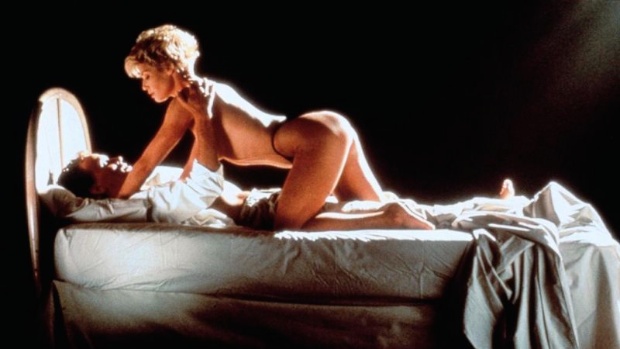 Back to selection
Back to selection
Screening Abel Ferrara’s Director’s Cut of Cat Chaser
 Peter Weller and Kelly McGillis in Cat Chaser
Peter Weller and Kelly McGillis in Cat Chaser After Cat Chaser, Abel Ferrera was reluctant to give up final cut again, not without a fight anyways. The erotic thriller’s 1989 theatrical release, complete with a clunky voiceover ghosted by another actor because leading hunk Peter Weller refused, has a fundamentally different character from Ferrera’s director’s cut currently housed in the basement at Anthology Film Archives. Last Tuesday, Anthology screened the only known copy, on video with time code, a rough audio mix, and without a score, for the first time maybe ever since it played on the Fox lot to studio bigwigs in the ’80s. That’s the last time its editor Anthony Redman remembers seeing the original cut anyways. “They hated it,” Redman told the audience Tuesday. “That’s probably a good thing.”
Redman means that for risk-adverse studio execs, “liking” a film is a sign that it’s probably pretty crappy. So, maybe it’s a good thing Fox ruined Cat Chaser so gloriously because the experience made Ferrera allergic to compromise for the rest of his career. Maybe we owe Bad LieutenantKing of New York and Mary in part to the hack job the soon-to-be-bankrupt Vestron Pictures did to Cat Chaser only a couple years before.
Ferrera independently produced his first films in the late ’70s and early ’80s. With the name he made for himself directing gritty urban slashers like Ms. 45, he started getting TV and studio film jobs. Cat Chaser is at the tail end of that string of work Ferrera took as a hired gun. Save for Body Snatchers (1993), a Warners Brothers joint, everything the director done since has been fiercely independent, much of it financed by foreign-sales driven French money.
The director’s cut of Cat Chaser opens on Weller’s character, George Moran, cleaning the pool of the dumpy Miami hotel he owns. Moran is a sun-leathered ex-marine with a rich ex-wife. His past is tangled up with the U.S.’s intervention in the Dominican Republic as well as a certain polo-loving country club crowd. All the characters’ pasts seem to lead back to the D.R., including the former head of the secret police who escaped to Miami where he made a fortune after the revolution. Moran starts sleeping with the man’s wife, played by Kelly McGillis, three years and a sexy cropped haircut since Top Gun. We don’t sympathize with the husband because he supposedly used to torture people. And while everyone is busy double crossing one another, McGillis, in typical ’80s glam style, is lit with a bar of light across her eyes through the whole film.
From even that first scene by the pool, we get a sense of Moran’s dry wit and the offbeat banter that’s largely been excavated in the theatrical cut. American crime novelist Elmore Leonard wrote the novel the film’s based on and, along with James Borelli, adapted it into the dialogue-heavy screenplay. Redman, the editor who worked with Ferrera on the original version and then was hired by the producers to chop it down to the theatrical cut, most laments having taken the knife to the murder scene. Following the ethic “a little less conversation, a little more action,” the ill-fated shower scene loses much of the deliciously uncomfortable dialogue, but at least retains its penises-and-pulp carnage. The original version of the hot-and-heavy love scene, however, is what I missed most in the theatrical cut. (Out of character for a Ferrera film, there’s really just one scene with sex and one with gore.) Unsurprisingly, the softcore shots of McGillis’s statuesque upper half didn’t end up on the cutting room floor, but Weller’s orgasmic yelp did, along with the post-coitus conversation between the lovers about how he’d “never done that before.” It’s a scene cut with a raw humor — it got laughs from the audience Tuesday — but it also develops a realistic intimacy between the couple that makes the risks they take the rest of the film actually believable.
It’s rare for a Ferrera film to take place outside of New York, and even in the director’s cut of Cat Chaser, set in Miami and the D.R., though the latter is really filmed in Puerto Rica, the city as a character feels missing. The director’s latest, Pasolini, also strays from New York; Ferrera’s biopic on the Italian director starring Willem Dafoe, will play at Venice next month and then Toronto, and we’ll look forward to seeing if he can fuse his tale of a driven artist’s death wish with an apt evocation of ’70s Rome.
